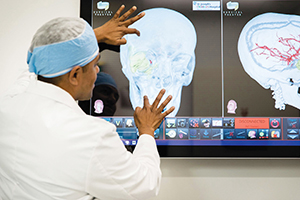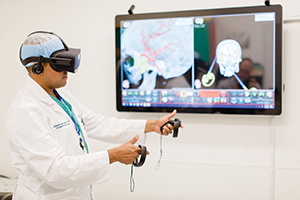By DALE SINGER
When you're 10 years old and you have a rare bone disease causing problems inside your skull, you'd be forgiven for not getting excited over a new piece of medical equipment. But everyone is fascinated with their own bodies and Johnny Edenfield was no exception.

Dr. Abilash Haridas, chief of pediatric neurosurgery at St. Joseph's Children's Hospital in Tampa, Fla., uses virtual reality technology in pre-surgery consults to give his patients and their parents a clearer understanding of treatment options and risks.
He was wowed when he put on a virtual reality headset and saw exactly how Dr. Abilash Haridas, chief of pediatric neurosurgery at St. Joseph's Children's Hospital in Tampa, Fla., planned to enter his cranium, slice away bone and relieve his painful symptoms.
"All he kept saying," Haridas recalls, "was 'That's cool, that's cool.'"
The Surgical Theater Precision Virtual Reality system in use at the pediatric hospital lets pediatric heart and brain surgeons combine and enhance traditional medical images from CT scans and MRIs and create a 360-degree model specific to their individual patient's anatomy and then navigate around inside the model.
The technology was developed by Israeli fighter jet pilots for use in flight simulations. Surgeons can use it to try out various approaches to the case at hand, analyze the instant problem from different angles and map out the best tactics.
Haridas was onboard from his first encounter with the technology when he saw just a little piece of its potential. "They brought this VR system into my office, to show me what it can and can't do," he says. "I was excited. I had never seen anything like it before."
Prior to Johnny's operation on July 18, Haridas used the technology to show the boy — in stereovision — how he would resect a bony growth pressing on an optic nerve, causing discomfort and vision problems. Johnny's parents followed along on a large flat-screened monitor mounted on the wall.
"We were very interested in it," Sherry Edenfield, Johnny's mother, says of the technology. It made it much easier for Johnny "to understand what was going on, instead of just drawing his own conclusions. The whole family got the bigger picture and a better understanding of what was going on."
That is one of the greatest advantages of the VR technology, Haridas says.

Dr. Abilash Haridas, chief of pediatric neurosurgery at St. Joseph's Children's Hospital in Tampa, Fla., wears a virtual reality headset that shows him a 3-D image as he navigates a 360-degree model of a human skull.
"Sometimes we have to spend a lot of time explaining what is going on and why it's serious," Haridas says. Giving a patient and his or her parents the opportunity to see inside the patient's body can provide a fuller understanding of complex anatomy and pathology, as well as treatment options and risks.
"It takes some heavy medical terminology out of the conversation. The biggest benefit I found is the way technology can speak to a patient in a way a doctor cannot," Haridas adds.
"Being invested in your own health care," Haridas says, "the more you know, the better informed you'll be and the more confident you'll be going into whatever treatment you get, surgery or no surgery.
"Dealing with kids and their families, they want to know everything. For all of the questions they have, the answers are on the screen, and it keeps the conversation focused on what really matters."
When the subject of a surgical consult involves your child's brain, Edenfield emphasizes, any tool that removes part of the mystery and increases understanding is welcome.
Edenfield acknowledges that the intensity of VR is undeniable. "But I would say that once you sit down and actually process what you see, and what you don't, it takes you to a new level of understanding. It's that amazing. They can draw a picture and show you a model, but it's nothing until you see this.
"Everything about it was positive," Edenfield says of the surgical consult employing VR. "There was nothing really negative about it. It wasn't that terrifying, really, once we were able to see what was damaged in there," she says. "It made a big difference. This takes pictures to a whole different level. It's hard to explain until people see it for themselves."
Haridas says pediatric patients who are gamers are in their element with the VR technology.
"It has all the features of a video game," he says. "That's the world they know. It's the language they speak well. They gravitate toward it and feel more comfortable with it."
Medical personnel may not be as familiar with VR technology as some of their young patients are, but Haridas says most of his colleagues are gaining proficiency.
He says there's been a learning curve to figure out the best way to take maximum advantage of the VR tool.
"We definitely started off slow, when we were first using the technology," he says, "but now we can maximize the potential of the technology. It's like riding a bicycle — the more times you use it, the more efficient you get."
"Any technology has limitations," Haridas concedes. "It can take up a little more space and a little more time in the office. People tend not to put down the technology and keep asking questions and playing with it. But we found ways around that pretty quickly."
Edenfield allows that Johnny was so fascinated with what he saw tooling around inside his own skull, he would have sat and played with the technology all day if he could.
Very cool indeed.